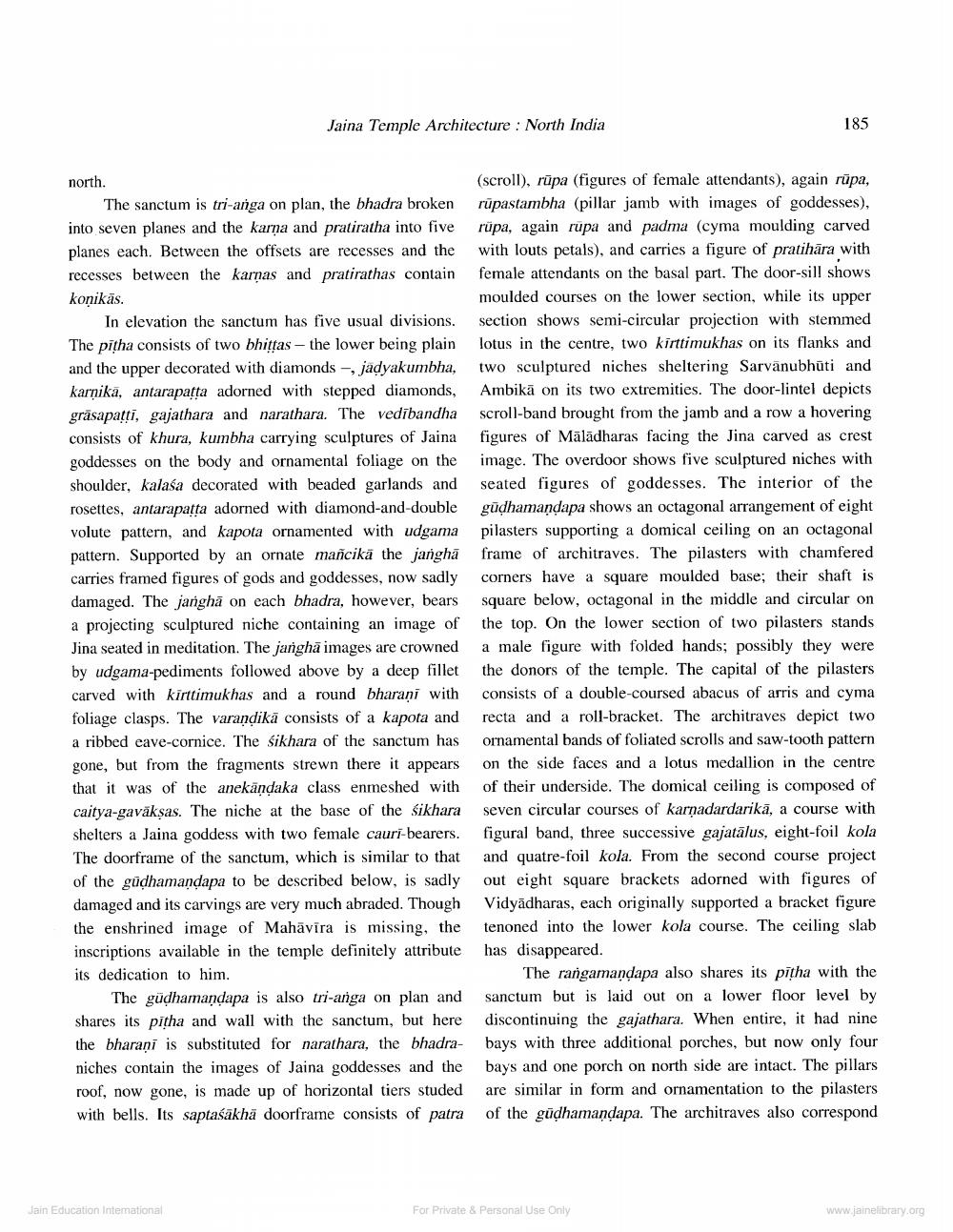________________
Jaina Temple Architecture : North India
185
north.
The sanctum is tri-anga on plan, the bhadra broken into seven planes and the karma and pratiratha into five planes each. Between the offsets are recesses and the recesses between the karmas and pratirathas contain konikās.
In elevation the sanctum has five usual divisions. The pitha consists of two bhittas – the lower being plain and the upper decorated with diamonds -, jadyakumbha, karņika, antarapatta adorned with stepped diamonds, grāsapatti, gajathara and narathara. The vedibandha consists of khura, kumbha carrying sculptures of Jaina goddesses on the body and ornamental foliage on the shoulder, kalasa decorated with beaded garlands and rosettes, antarapatta adorned with diamond-and-double volute pattern, and kapota ornamented with udgama pattern. Supported by an ornate mañcikä the janghā carries framed figures of gods and goddesses, now sadly damaged. The janghä on each bhadra, however, bears a projecting sculptured niche containing an image of Jina seated in meditation. The janghā images are crowned by udgama-pediments followed above by a deep fillet carved with kirttimukhas and a round bharaṇi with foliage clasps. The varandikā consists of a kapota and a ribbed cave-cornice. The sikhara of the sanctum has gone, but from the fragments strewn there it appears that it was of the anekāndaka class enmeshed with caitya-gaväksas. The niche at the base of the Sikhara shelters a Jaina goddess with two female cauri-bearers. The doorframe of the sanctum, which is similar to that of the gūdhamandapa to be described below, is sadly damaged and its carvings are very much abraded. Though the enshrined image of Mahāvīra is missing, the inscriptions available in the temple definitely attribute its dedication to him.
The güdhamandapa is also tri-anga on plan and shares its pitha and wall with the sanctum, but here the bharani is substituted for narathara, the bhadra- niches contain the images of Jaina goddesses and the roof, now gone, is made up of horizontal tiers studed with bells. Its saptaśākhä doorframe consists of patra
(scroll), rūpa (figures of female attendants), again rupa, rūpastambha (pillar jamb with images of goddesses). rüpa, again rupa and padma (cyma moulding carved with louts petals), and carries a figure of pratihāra with female attendants on the basal part. The door-sill shows moulded courses on the lower section, while its upper section shows semi-circular projection with stemmed lotus in the centre, two kirttimukhas on its flanks and two sculptured niches sheltering Sarvänubhūti and Ambikā on its two extremities. The door-lintel depicts scroll-band brought from the jamb and a row a hovering figures of Mālādharas facing the Jina carved as crest image. The overdoor shows five sculptured niches with seated figures of goddesses. The interior of the gūdhamandapa shows an octagonal arrangement of eight pilasters supporting a domical ceiling on an octagonal frame of architraves. The pilasters with chamfered corners have a square moulded base; their shaft is square below, octagonal in the middle and circular on the top. On the lower section of two pilasters stands a male figure with folded hands; possibly they were the donors of the temple. The capital of the pilasters consists of a double-coursed abacus of arris and cyma recta and a roll-bracket. The architraves depict two ornamental bands of foliated scrolls and saw-tooth pattern on the side faces and a lotus medallion in the centre of their underside. The domical ceiling is composed of seven circular courses of karnadardarikā, a course with figural band, three successive gajatālus, eight-foil kola and quatre-foil kola. From the second course project out eight square brackets adorned with figures of Vidyādharas, each originally supported a bracket figure tenoned into the lower kola course. The ceiling slab has disappeared.
The rangamandapa also shares its pitha with the sanctum but is laid out on a lower floor level by discontinuing the gajathara. When entire, it had nine bays with three additional porches, but now only four bays and one porch on north side are intact. The pillars are similar in form and ornamentation to the pilasters of the gūdhamandapa. The architraves also correspond
Jain Education Intemational
For Private & Personal Use Only
www.jainelibrary.org




